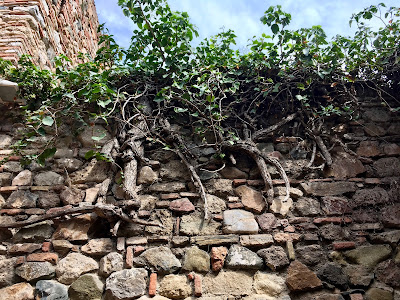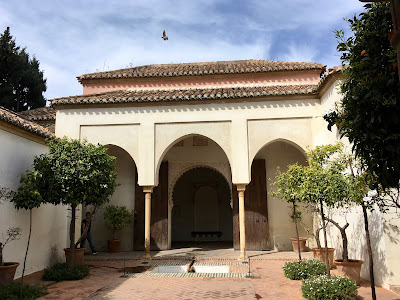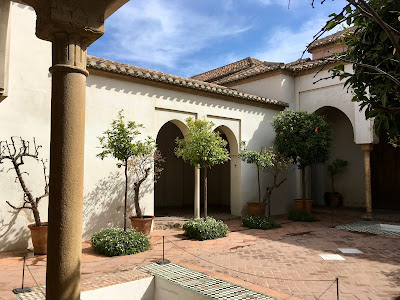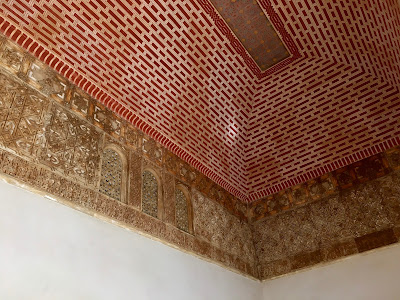Our second day in Malaga we strolled east past the cathedral to the Alcazaba - a short 6 minute walk from our flat - and as it was such a glorious day we decided to explore its interior.
The Alcazaba is of Moorish construction and while the Moors established themselves in Malaga in the year 711 the palace complex was built considerably later - in the 11th century.
 |
| The entrance off Calle Cister (Cister Street) |
The fortress is built on a hill in the heart of Malaga which made for a slow, but steady incline to the top.
When we reached this particular point...
...we were treated to the most wonderful aroma of orange blossoms and like other visitors paused to watch a swarm of bees feasting on the nectar.
I, of course, had to mention a gazillion times "This is February!" and pinched myself numerous times that I wasn't dreaming!
Around every corner there was an "OMG" moment when the view was so spectacular it called for a photo op. Having learned how much John dislikes selfies, I asked a young woman for her assistance and before he had time to moan and/or decline - tada - photo taken!
The Moors constructed the Alcazaba over the ruins of a Roman fortress, completing it in 1063.
This particular period was one of great insecurity and for this reason the Alcazaba is one of the more defensive buildings in all of Spain.
These next few photos show the vantage point the Alcazaba inhabitants had over invaders.
Built in the Nasrite style the Alcazaba's ponds, gardens and horseshoe arches are serene and peaceful spaces.
 |
| Front view of vine growing above bench |
 |
| Back view of vine on the back of the wall |
There were also a number of rooms set aside to showcase original pottery used by the palace occupants.
The detail of the moorish art is both inspiring and calming at the same time. One can only imagine how incredible these rooms must have looked when freshly completed in the 11th century.
At the summit of the Alcazaba we surveyed the surrounding countryside and like the pigeons who opted to rest on the rooftops we stopped to admire the spectacular views.
 |
| Four pigeons |
At the foot of the Alcazaba is a Roman theatre. Construction was completed in the 1st century AD and over time it was buried and forgotten - so much so that a modern building was built over top it in the 1940s. When city officials realized it could be a significant draw for tourists the modern building was demolished in the 1990s. Today, it is a venue for various drama, dance and concert performances.
Directly across from the Roman Theatre is the El Pimpi Bodega Bar and Restaurant where we stopped for lunch.
 |
| Photo courtesy of Google |
The olives and bread are the tapas that come with our wine. Then we shared the "lightly-battered aubergine with sugarcane syrup dressing (the best yet, btw!) and the "crispy breadcrumb parcel of Iberian ham, loin of pork and melted cheese." Delicious!
* * *























































